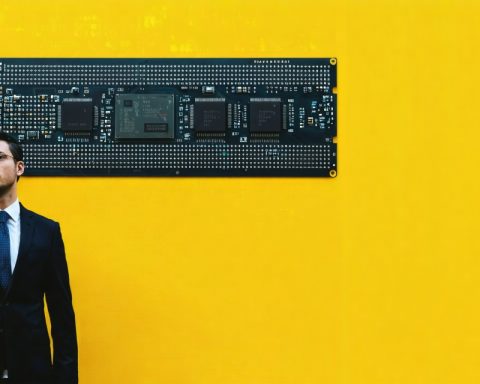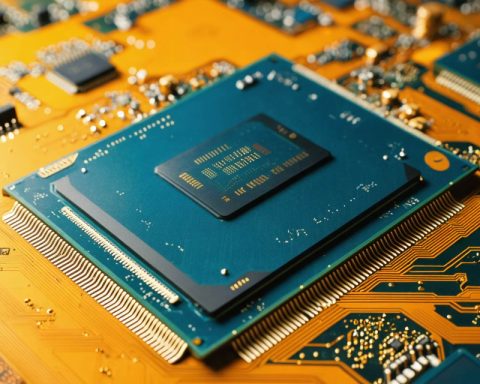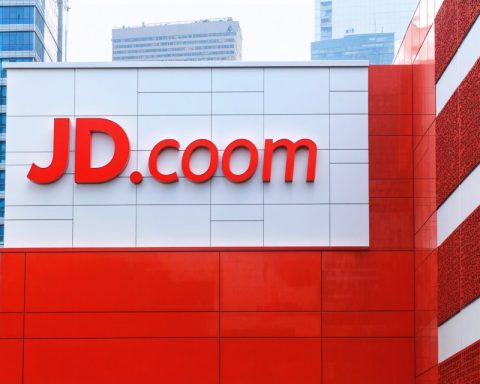- Intel, led by CEO Lip-Bu Tan, aims to challenge TSMC with its advanced 18A process node, setting new standards for chip efficiency and performance.
- A potential Intel-Nvidia partnership could reshape the semiconductor landscape, with Intel’s foundries addressing Nvidia’s gaming GPU shortages.
- Nvidia, faced with high demand for gaming GPUs and global supply chain issues, benefits from diversifying production sources.
- Intel’s U.S.-based foundries offer Nvidia a geopolitical advantage amidst trade tensions with Taiwan.
- A partnership could bolster Intel’s market perception and investor confidence, reinforcing its pioneering efforts at a technological renaissance.
- While the potential alliance is transformative, actual benefits may not be seen until 2026, reflecting the strategic foresight required in the tech industry.
A seismic shift is brewing in the semiconductor industry as Intel, under the leadership of its new CEO Lip-Bu Tan, positions itself to challenge the industry giant Taiwan Semiconductor Manufacturing Company (TSMC). The central element of this strategy is Intel’s cutting-edge 18A process node, a technological marvel poised to redefine efficiency and performance benchmarks in chip manufacturing.
As the stage is set, whispers circulate in the technology corridors about a potential partnership between Intel and Nvidia, the latter being the undisputed titan of the fabless chip design world. Securing Nvidia as a foundry customer could mark a pivotal turn in Intel’s resurgence, a testament to the prowess of its ambitious 18A process.
Why would Nvidia, a powerhouse in AI-driven solutions and gaming graphics, consider redirecting its allegiance to Intel? Nvidia finds itself entangled in its own supply labyrinth, struggling to cater to the surging demand for gaming GPUs, particularly following the launch of its much-discussed RTX 50 series. Gaming enthusiasts, starved of supply, have witnessed prices soar beyond MSRP, with frustrations mounting as Nvidia’s competitors, like AMD, make aggressive inroads with their impressive RX 9000 graphics cards.
For Nvidia, the calculus is simple yet profound: Optimize production for its lucrative AI chips with TSMC while alleviating gaming GPU shortages through Intel’s burgeoning capacities. This strategic pivot might not only enhance Nvidia’s market standing but also insulate it from geopolitical tremors and tariffs affecting Taiwan’s tech exports to the U.S.
This potential alignment sounds like a win-win scenario, but will Nvidia make the leap? Intel’s foundries in the U.S. offer a distinct geopolitical advantage at a time when Washington appears keen on reviving American manufacturing might—an opportunity Nvidia might find too tempting to ignore.
Shifting focus back to Intel, winning Nvidia as a customer could light the path for its own rebirth narrative. While financial returns from any such deal might not illuminate Intel’s immediate books, the optics of scoring Nvidia could buoy its investors, curbing skepticism and fostering confidence in Intel’s pioneering 18A process.
However, it’s crucial to acknowledge the speculative nature of these tidings. Even with Nvidia potentially on board, the dividends of such a partnership might not manifest until new products roll out, possibly in 2026.
Standing at this crossroads, Intel’s future glitter is couched in possibilities. A partnership with Nvidia would not only serve as an early victory lap for Tan but also act as a beckon of hope for Intel as it strives to reclaim technological dominance. This pivotal journey underscores Intel’s tenacity and vision, reiterating that in the ever-evolving tech landscape, ambitious pursuits coupled with strategic foresight can indeed reshape destiny.
The entire scenario illustrates the ripple effects a single strategic alliance can have on reshaping industry dynamics, proving again that in the world of semiconductors, fortunes can change as swiftly as the technologies that drive them.
Could Nvidia’s Partnership with Intel Transform the Semiconductor Industry?
The Current Landscape of the Semiconductor Industry
The semiconductor industry is experiencing seismic changes, particularly with Intel’s newfound ambition to compete with industry heavyweight Taiwan Semiconductor Manufacturing Company (TSMC). Under CEO Lip-Bu Tan’s leadership, Intel is leveraging its revolutionary 18A process node technology to achieve this goal. This breakthrough is set to redefine chip manufacturing efficiency and performance benchmarks.
Potential Partnership: Intel and Nvidia
One particularly buzzing topic is the prospect of a strategic partnership between Intel and Nvidia. Nvidia is a dominant player in AI solutions and gaming graphics, currently entangled in supply issues. The suggestion is that partnering with Intel could help Nvidia optimize its production strategies by focusing TSMC’s resources on its AI chips, while relying on Intel for its gaming GPUs. Given the geopolitical tensions affecting Taiwan’s tech exports to the U.S., Intel’s U.S.-based foundries offer Nvidia a stable and geographically convenient alternative.
Key Advantages of the Intel-Nvidia Collaboration
1. Geopolitical Security: Intel’s production facilities in the U.S. provide Nvidia with a buffer against international trade tensions, offering location-based advantages that align with Washington’s push for domestic manufacturing.
2. Technological Synergy: Intel’s 18A process node could offer transformative improvements in terms of power efficiency and processing capabilities for Nvidia’s next-gen products.
3. Market Dynamics: This partnership could change the dynamics in the semiconductor market, reducing Nvidia’s dependency on TSMC and aligning more closely with American innovation agendas.
How-To Steps & Life Hacks for Companies
– Analyze Supply Chains: Companies should scrutinize supply chain dependencies, assessing geopolitical risks, and diversifying production sites for stability.
– Leverage Partnerships: Collaboration with technology partners can yield substantial benefits in terms of cost-sharing and innovation acceleration.
Market Forecasts & Industry Trends
The semiconductor market is expected to show resilient growth, driven by the burgeoning demands of AI, gaming, and IoT applications. By 2025, the industry is projected to achieve a value of approximately $726 billion, a significant leap facilitated by partnerships, technological innovations, and strategic investments.
Pros and Cons Overview
Pros:
– Enhanced geopolitical security for Nvidia.
– Improved production capacity and efficiency for gaming GPUs.
– Strengthened presence in the American market for both entities.
Cons:
– High initial transition costs and technological integration challenges.
– Potential risk if the partnership affects Nvidia’s relationship with TSMC adversely.
Actionable Recommendations
– For Nvidia: Leverage Intel’s U.S.-based infrastructure to address GPU shortages and enhance product timelines.
– For Intel: Ensuring seamless integration with Nvidia’s production processes can build investor confidence in the 18A node technology.
– For Investors: Keep a close watch on strategic partnerships in the semiconductor space as indicators of future growth potential.
Conclusion
While speculative, an Intel-Nvidia partnership chronicles a compelling strategic pivot that could have a profound ripple effect on the semiconductor industry. The implications of such a collaboration could be momentous, reshaping supply chain dynamics and setting new standards in chip performance.











